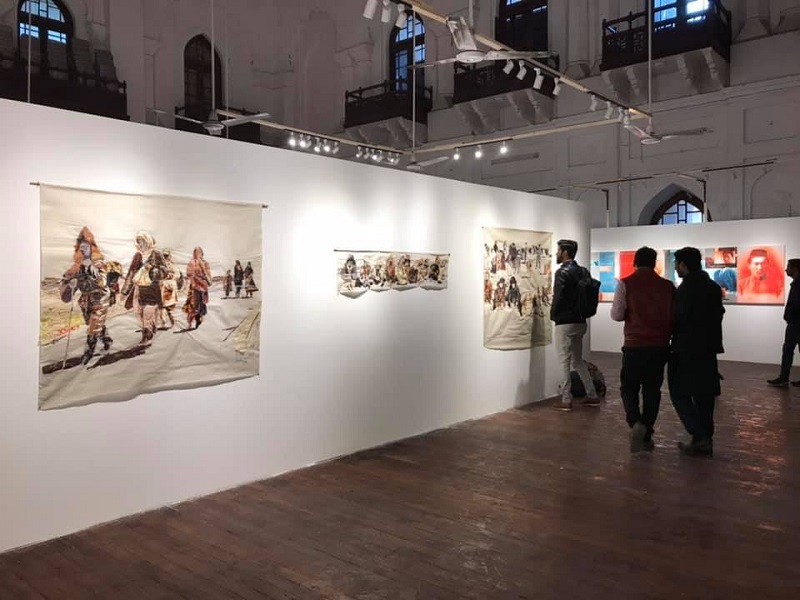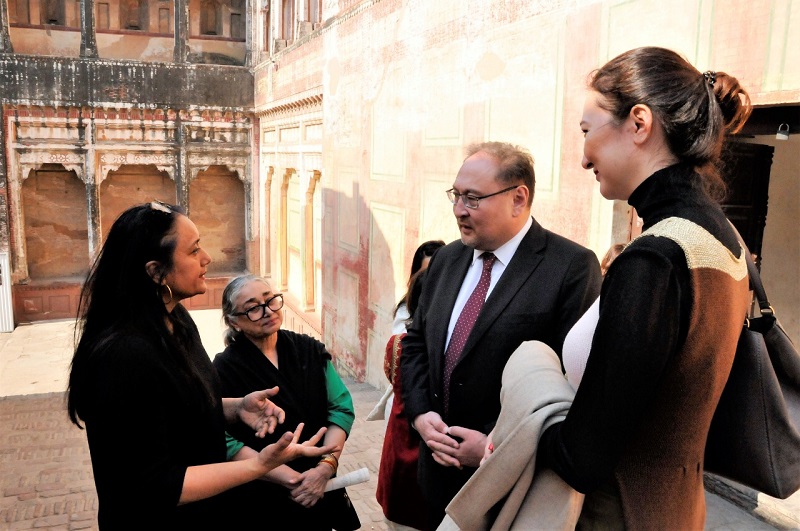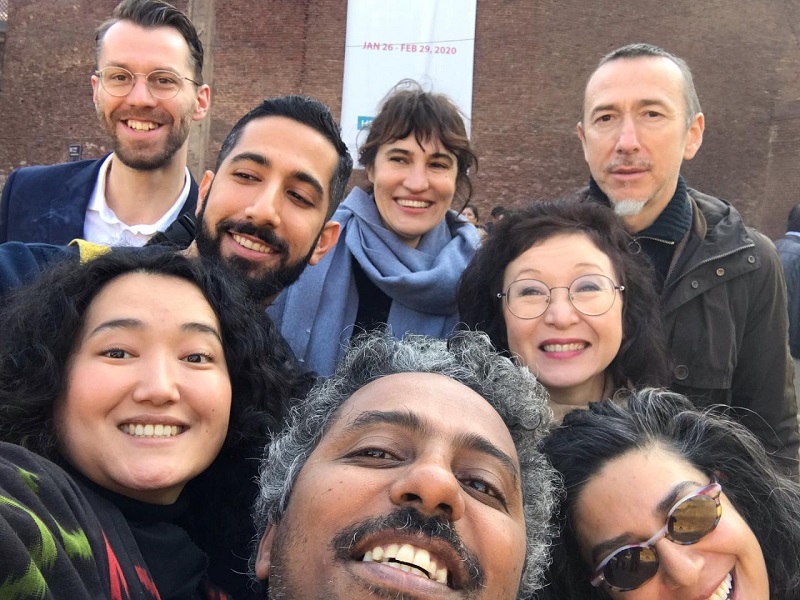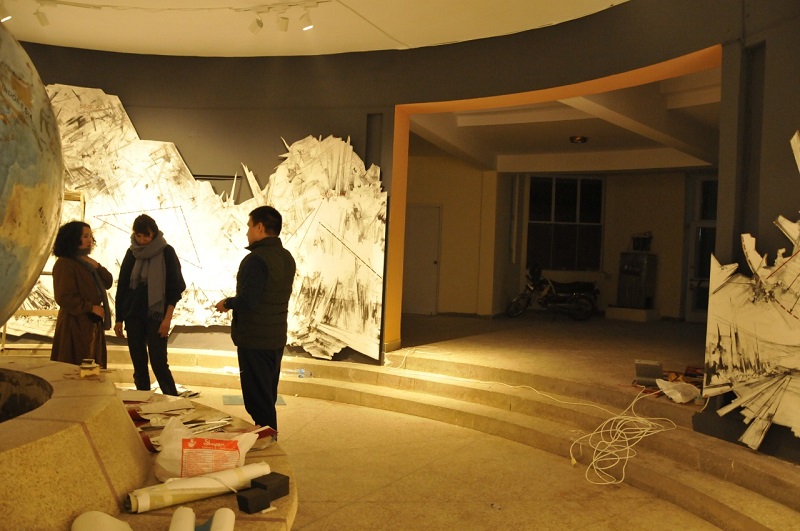By Ms. Ajar Sabraliyeva-Tynybek
The Lahore Biennale 02 (LB02) kicked off at Huzuri Bagh Lahore Fort on January 26, 2020 under the title “Between the Sun and the Moon” with some prominent painters from Kazakhstan namely Ms. Almagul Menlibayeva, Ms. Zitta Sultanbayeva, Ms. Saule Suleimenova, Mr. Syrlybek Bekbotayev and Mr. Roman Zakharov being part of it.
The biennale featuring diverse and public art works, academic talks and film screenings will continue till February 29.
Right upon our arrival from Islamabad, the ancient city of Lahore welcomed us with its heart-breaking intense traffic: Rakshas, donkey-carts, tourist buses, bikes were all swiftly on a move, sometimes being close to crash with each other, and at the same time being altogether like an unbelievable chaotic mess.
The city is noticeably up because of two major international events being held here – Modern Art Biennale and arrival of Bangladesh’s national team of cricket, the game, which people of Pakistan are simply obsessed with. Strict security measures are seen everywhere around. Some traffic roads are not functioning because of this and main streets are being secured by gunmen. Along roads there are many booming mobile power generators with turned on spotlights, which are hot enough to be even used as a heater. Night time appears to be like a day and the whole environment resembles to a decoration for a movie screening.

Ms. Almagul Menlibayeva arrived at Pakistan well in advance. The art project, she worked out in collaboration with Ms. Inna Artyomova (Germany) and Mr. German Popov (the Netherlands), is indeed hard to implement and is time-consuming in terms of being properly crafted. This is all about their art project, known under the name of «Ulugh Beg: The Intrinsic Futuristic Machine of Central Asia 2020”.
In my previous appearance in Lahore last year in March LB02 curator Ms. Sheikha Hoor Al-Qasimi suggested to show me the local Planetarium for my new art project. But then the Planetarium was closed what made it impossible for us to examine it from the within. But later we came to a conviction that we could really utilize it as our art project. The more surprising and unusual suggestion is, the more interesting and challengeable it seems to be.

You know, all Biennales constantly change their geographic location and respectively are like to alter your mindset. They have an ability to revise and to reconstruct everything. Blending sometimes things, which seem to be totally incompatible.
We both agreed to see each other almost by 10 pm as the painters had no time as were obviously in a rush as they still needed to tune their technical facilities. There is a little time room left before the inauguration of the Biennale to open. There is all around a strong impression of ongoing repair works or a massive removal. Some portion of technical facilities stands under the cover of cellophane, while shroud lines and part of a parachute are seen somewhere in the corner.

The art project of Ms. Almagul is about making 10 spotlights to project to the Planetarium’s dome videos, whose total time length is more than 100 hours. Producing all these video pieces took almost a year and covered mostly a life path of great Central Asian scholar Ulugh Beg and modern-day vision on his scientific legacy and discoveries.
In a dark corner of the hall, someone from the Kazakh technical team under the mess around him is working hard in his quest to tune the music while cosmic-style and Oriental tunes were already airing. Working talks, fatigue and passion, paper rolls, rulers, wires will all turn next day into an absolutely magic place. But now we are all trying to get relaxed while sitting on dusty arm-chairs and imagining on the dome surface a projection of a star abundant sky.
“Contemporary painters do not really care much about where exactly to present publicly their masterpieces”, – says Ms. Almagul.

She goes on to say: “There are indeed a lot of stereotypes about Pakistan. Mostly they are all about warnings of how insecure and troublesome place it can be or about widespread poverty in the country. But you know, there are two Biennales held in Pakistan, while not even a single one in Kazakhstan. I cannot say that Pakistan is a closed country but people still have to discover it. And it really needs to be done. We all have to talk on a people-to-people manner how this region was earlier linked with Central Asia and why we are apart today. The existence of linkage between Central and South Asia is undeniable but today it should be synthesized and well exercised afterwards. We have a lot of differences but at the same time our looks and names make strong evidence in favor of how many affinities we share as well.
Art changes thinking modes and mindset. Those young people who are likely to come at the Biennale may positively change mentally at once or maybe in 20 years. But what is of crucial importance is to be within a culturally diverse environment and live in harmony with it. This is what really has the power to change the mind. And later on quantity transforms into quality”.
“Lahore is a very romantic city”, – tells me at the Biennale’s inauguration ceremony Ms. Zura, who is a local architect and arts fan.
“Our city hosts plenty of exhibitions and people know here each other very well”, – she goes on to say.
I stared at people, who surrounded me at the inauguration ceremony, and identified many VIPs among them. This sort of events with personal participation of Pakistan’s President Arif Alvi was surely arranged for a limited number of attendees, who are allowed to get in according to invitation lists.
The Ambassador of Kazakhstan to Pakistan Mr. Akan Rakhmetullin did also arrive at Lahore to greet the Biennale participants from Kazakhstan.
But what impressed me the most after the end of the inaugural session with all VIPs gone was to see so many Pakistanis going to enjoy the Biennale. Prior to that moment I hardly believed to the organizers, who expected up to 3 million people overall to visit Biennale, but sizeable flows and enthusiasm of people I could see convinced me that organizers estimations could be correct.
Unbelievable blend of antiquity and modernity, both emanating from the Lahore Fort, darkened vaults, paintings and installations, which clearly state who we really are as human beings.
Polyphony of human voices around combined with soaring kites in the sky and call for praying really make the Lahore Biennale-like cultural events as mindset changing ones.
